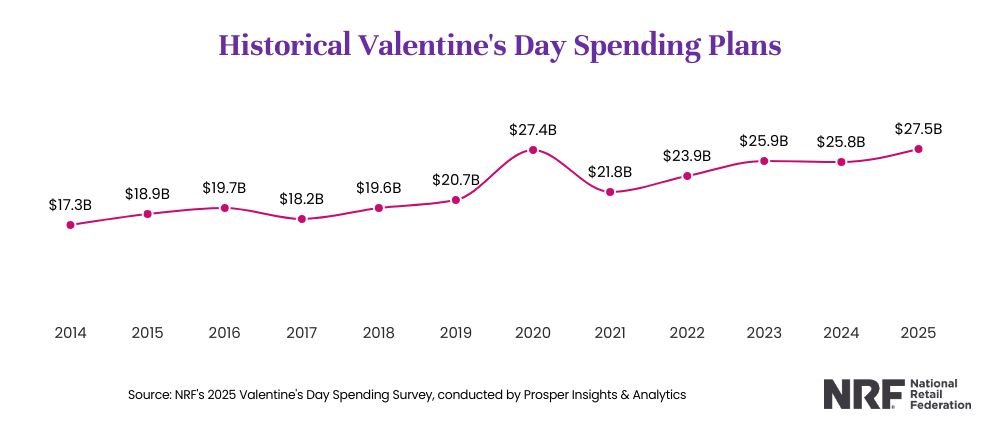My wife and I have been married for six years now. This post is NOT necessarily dedicated to her, but she did inspire me to write this. *heart*
I was in our kitchen on February 13th this year, and was frantically scrolling through overnight shipping options. My wife walked in, noticed my screen, and laughed.
Me: I’m sorry, I shouldn’t have waited till the last minute to buy you a Valentine’s Day gift.
She: What are you even doing? We agreed—no gifts this year.
She was right. We had agreed—multiple times. Yet there I was, about to spend somewhere around ₹6,500/- on a new fitness tracker that I realize would have insinuated that she wasn’t being fit.
Why? Because my inbox contained 37 emails with subject lines like “LAST CHANCE: Valentine’s Day Delivery!” and “Don’t Disappoint Her Tomorrow!” My social media feed showed friends unboxing heart-shaped jewelry. It felt like even my weather app somehow managed to remind me that Valentine’s Day was “tomorrow!”

I’m not alone in this experience. Many of us find ourselves caught in a web of commercial pressure that has little to do with our actual relationships. This phenomenon—where we feel compelled to participate in consumer rituals despite our own preferences—reveals much about modern marketing, digital influence, and how our most personal relationships are increasingly mediated by commercial interests.
What even is Valentine’s Day besides a capitalist Hallmark-fueled holiday?
So I did the research and it turns out that – unlike Black Friday – Valentine’s Day does have some historic significance. The origins of Valentine’s Day trace back to ancient Rome’s pagan festival, Lupercalia, held in mid-February to promote fertility. Nice.
The day became associated with St. Valentine, a Christian martyr executed around 270 CE for defying Roman laws by secretly officiating marriages. By the 14th century, thanks to writers like Geoffrey Chaucer, the day evolved into one celebrating romantic love. Traditions such as exchanging love letters and tokens began during this time.

In the 19th century, the Industrial Revolution popularized mass-produced Valentine’s cards, chocolates, and flowers. Companies like Hallmark further commercialized the holiday in the early 20th century.
Today, Valentine’s Day is a major retail event, with billions spent annually on gifts, driven by marketing campaigns that are supposed to emphasize material expressions of love.
The Valentine’s Day Industrial Complex
The numbers behind Valentine’s Day spending are staggering:
- Americans spent an estimated $25.9 billion on Valentine’s Day in 2023, according to the National Retail Federation (NRF)
- The average person spent $192.80 on Valentine’s Day gifts and celebrations
- Over 53% of Americans planned to celebrate the holiday, whether they wanted to or not

Behind these figures lies an aggressive marketing machine that begins ramping up immediately after Christmas. Digital marketing for Valentine’s Day has evolved into a sophisticated operation that creates what psychologists call “anticipated regret”—the fear that failing to participate will lead to social consequences.
The Digital Pressure Campaign
Valentine’s Day marketing has perfected the art of making people feel that their relationships will be judged based on their participation in this commercial ritual. It’s no longer about expressing love—it’s about proving you’re not failing at love.
Dr. Ellen Langer, Professor of Psychology at Harvard University
This pressure manifests across multiple digital channels:
- Email marketing campaigns increase by 278% in the two weeks leading up to Valentine’s Day
- Social media posts featuring Valentine’s Day content receive 37% more engagement than regular posts in February
- Search interest for “Valentine’s gift ideas” increases by over 300% in early February
What People Actually Want vs. What They Buy
Perhaps the most revealing statistic: in a 2022 survey by the relationship research firm The Gottman Institute, 64% of couples reported that they would prefer quality time together over gifts, yet 78% still exchanged presents.
There’s a significant gap between what people say they want and what they feel obligated to do. This discrepancy creates stress in relationships and undermines authentic connection.
Dr. John Gottman
When asked what they would prefer for Valentine’s Day:
- 64% said quality time together
- 18% preferred a shared experience (like dinner out)
- 11% wanted physical intimacy
- Only 7% listed a material gift as their top preference
Yet when asked what they typically do:
- 82% exchange material gifts
- 67% buy greeting cards
- 55% purchase flowers or chocolate
The Commercialization Timeline
Valentine’s Day wasn’t always a commercial juggernaut. Its transformation from a religious observance to a gift-giving obligation followed a calculated path:
- 1840s: The first mass-produced Valentine’s cards appear in the United States
- 1907: Hershey’s introduces their chocolate “Kisses”
- 1913: Hallmark begins mass-producing Valentine’s cards
- 1980s: Diamond industry begins promoting Valentine’s Day as a jewelry-giving occasion
- 2000s: Digital marketing transforms the holiday into a multi-week commercial event
Valentine’s Day represents one of the most successful marketing campaigns in history. It transformed a minor holiday into a mandatory consumption event.
marketing historian Dr. Nancy Koehn of Harvard Business School
Google “Valentine’s Day buying guide” and you’ll see tons of websites – your favorite websites too – offering buying guides. And don’t even get me started on the social media so-called influencers.

When you see one of these pages, make sure you look for the ethics policy. The Verge for example is very good of putting their ethics policy front and centre – making it well known that these are affiliate links.

The reason this is important is that you should be aware that products listed on a website – especially these buying guides – are for the purpose of the website making money. That’s why they want you to buy the products listed on their website. There is a natural conflict of interest there, especially if the website claims to be a tech review site which is supposed to objective suggest to you where you spend your money.
Breaking Free From the Valentine’s Industrial Complex
So how do we reclaim this holiday from the digital marketing machine?
The healthiest approach is explicit communication. Have a direct conversation about expectations. Ask, ‘What would make this day meaningful for you?’ And be honest about your own preferences.
Dr. Alexandra Solomon, Couples Therapist
Other strategies for resisting the commercial pressure include:
- Establish your own traditions. Create Valentine’s rituals that reflect your actual relationship, not what marketers prescribe.
- Unsubscribe and unfollow. Reduce exposure to marketing messages by cleaning up your digital inputs in January.
- Schedule a relationship check-in. Use February as a time to discuss your relationship’s health rather than focusing on gifts.
- Reframe the narrative. Remember that participation in commercial aspects of Valentine’s Day is optional, not mandatory.

My (Our) Personal Resolution
After my near-purchase this February, my wife and I had a frank conversation. We discovered that neither of us enjoyed the pressure of Valentine’s Day gift exchanges. This year, we’ve decided to spend the Friday evening taking our dog for a long walk along the beach —something we both genuinely enjoy. *aww*
The irony isn’t lost on me: I’m writing this blog post still surrounded by Valentine’s Day advertisements. My inbox still contains “urgent” reminders about shipping deadlines. But I’m no longer clicking on them.
Because the truth is, my wife never wanted a Valentine’s Day gift. The internet did.
I did buy my wife something – today
Here’s a conversation I had with my wife this morning:
She: I did the research and would like you to buy me a [product name I’m not mentioning because I don’t endorse or take sponsorships for now] because I feel it will make me more productive at work.
Me: But Valentine’s Day was more than two weeks ago!
She: Who said anything about Valentine’s Day?
She had a need, which turned into a want, and I bought [product name I’m not mentioning because I don’t endorse or take sponsorships for now] to meet that need / want. She since then spent one full day doing productive work, and here’s wishing her many more days of productive work to come.
I am thrilled we are not doing Valentine’s Day gifts any more. I am further thrilled that when we decided to spend money on fulfilling a need or a want of ours, and not to fulfill the commercial need of the internet’s massive advertisement / affiliate industry to buy something off a website – that’s when value is transferred to the internet and not me. And the internet is not my valentine, my wife is.
And in all honesty, who apart from the internet genuinely cares about Valentine’s Day anyway? My wife never wanted a Valentine’s Day gift, the internet did.
Thank you for reading! My name is Erick and I am an Indian Tech blogger and content creator. I talk about more than just new gadgets and software – I talk about tech policy, trends and consumer behaviors that you need to know about and that could be affecting you, so you can make more informed tech related decisions. I stay out of sponsorships, affiliates or sponsored content so that you can be assured that my reporting is completely independent.
Share this post with a friend or family member who should read it, or share it on your social media. And do follow me on the platform you use the most:
